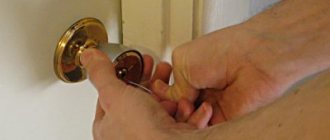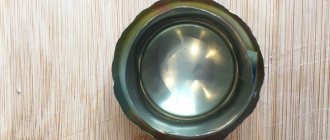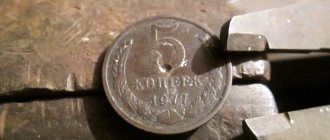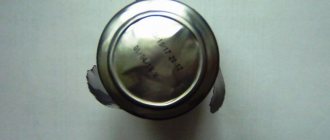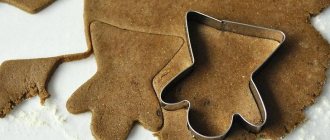Posting in the group: Useful tips
The need to open canned food with improvised objects is a very common situation that occurs in nature and other conditions outside the home. In fact, it is possible to do this without a bottle opener. The lid of a can is actually a very thin piece of metal pressed against the body.
Most kitchen utensils (knives, spoons, even forks) are stronger and thicker, so they can pierce most canned food containers without too much effort.
What and how to open canned food?
If you apply force at the right angle and with the right pressure, a tin can can be opened with many available objects. Without a special opener, you can make a small hole in the lid. Next, you can use a spoon or its handle to widen the opening.
At the same time, it is important to be careful - often when opening canned food with objects not intended for this purpose, very sharp edges are formed, which are easy to injure.
A regular bottle opener
Using a can opener is the easiest way to open cans and is the recommended method. Common devices designed for this task are known as can openers.
The principle of their operation looks like this:
- It is necessary to place the opener perpendicular to the edge of the lid, hold it firmly in this position with your hands and apply force with pushing or striking movements until the tip of the blade makes a hole.
- Then you should push the blade into the pierced part of the lid and move the opener in a circle along the edge of the lid, holding it firmly by the handle with the blade facing forward.
- As a result, the lid will be separated from the container and can be lifted and removed.
Opener with wheel
Opening canned food with a modified opener is convenient when hiking and during outdoor activities. This device is equipped with a toothed wheel, is compact in size and light in weight.
It is very easy to open canned food:
- The wheel must be installed on the edge of the can lid and secured to the convex rim.
- Then you need to squeeze the handles of the device with your hands.
- As a result, the wheel breaks through the metal cover, which is accompanied by a loud hissing sound.
How to open canned food with a wheeled opener. - Next, you need to turn the container to cut off the top of the can in a circle, after which you can pick it up with a knife or your hands and remove it.
Knife and its handle
Regular kitchen, chef's, or camping knives are common for opening canned food, almost on par with bottle openers.
With their help, you can easily open any jars by following a few simple steps:
- You need to place the can on a stable surface (a table at hip height is ideal).
- Then you need to stand over the can to be able to hold it steadily.
- Next, place the tip of the knife against the inner edge of the lid, setting it vertically and not at an angle. It is necessary to grasp the handle so that your fingers are not in the path of the blade if it slips. The back of the hand should be facing up. This method is more effective than trying to saw off the lid with a knife blade (which risks damaging the lid and introducing metal shavings into the food).
- You need to make sure that the knife is completely locked in place so that it does not slip (you can do this by lightly tapping the handle with the back of your hand).
- The second hand should lightly push the first, squeezing the handle. This slight movement will cause the tip of the knife to pierce the lid of the jar. Do not push your hand too hard, otherwise the blade may slip.
- After this, you need to tilt the knife and make a new hole, placing its tip a few centimeters higher and repeating the previous steps. You must continue to follow these instructions until holes have been made around the entire circumference of the canning lid. Then you just need to connect them with sawing and cutting movements, as when using a special opener.
- Finally, you need to finally tear off the lid with a knife and remove it with your hand covered with a towel or sleeve (this is recommended to protect against cuts and scratches).
Canned food can also be opened with the handle of a knife under certain conditions. For this method, a tool with a significant mass and a voluminous handle (chef’s and similar types) is suitable.
The process of opening iron cans using this method looks like this:
- The jar must be placed on a stable surface. Do not place it on your knees or between your legs, otherwise the knife may slip and cause injury.
- Next, you need to grab the top of the knife with your palm just above the junction of the blade and handle. Your fingers should rest on the side of the handle, at a safe distance. It is important to ensure that the tool is held securely. This method can be dangerous if your hands or knife slip.
- Then you should place the “heel” of the knife against the inner edge of the lid. This is the area where the blade is widest, located at the opposite end from the tip. It should be centered directly under where your palm grips the knife.
- You need to make sure that this area of the tool fits snugly against the edge of the lid to eliminate the risk of slipping, and press it firmly so that it pierces the jar, leaving a small hole. If you don’t have enough strength for this, you can stand up and lean over the container, increasing the impact on it.
- Now you need to hold the knife with one hand and put the second on top, press firmly and continuously with both hands on the tool until the can lid is pierced. However, do not hit the can to pierce it, as the knife may come off and cause injury. Instead, apply slow, even pressure until the container is pierced.
- Don't be tempted to pierce the jar with the sharp end of a knife. The heel is more stable and slips less. In addition, the tip of the blade can be damaged by this use.
- Next, you should tilt the knife, move it a few centimeters along the edge of the lid and make a new hole next to the first one, using the same technique.
- After this, you need to continue making holes in a circle along the edge of the jar lid. Then you need to insert the tip of the knife into one of them, press and push the blade in a circular motion, using the same force as when using a standard bottle opener.
- Finally, you can pry the lid with a knife and lift it up. It is recommended to point the blade away from you to prevent injury in case of slipping.
Before removing the lid completely, it is advisable to wrap your hand in a towel or sleeve, as the edges may be very sharp.
Hands
Almost anyone can open canned food with a can opener or a knife, unlike a very risky method that requires considerable effort and good physical fitness. This method always turns out to be quite dirty and sloppy. It is best used for large jars that have grooves or "ridges" around their circumference. However, it is recommended to resort to this method only as a last resort.
This is done like this:
- You need to tear off all the labels on the can and find the grooves.
- Then you need to grab the container with both hands from different ends, and rest your fingers on the grooves near the middle of the top of the can. If your hands are not strong or large enough to do this, you should place the container on the ground and press the grooves with the strongest part of your palms.
- As soon as a dent forms on one side of the can, you need to rotate the container 180° and reinsert your fingers into the grooves, and make dents on both sides in the same place as deeply as possible. To do this, you need to hold the container horizontally, resting your palms on it so that they press on areas closer to the edges, and not to the center.
- It is necessary to squeeze the ends of the can very tightly, pressing on them with your hands, and then repeat this step on the other side.
- Continuing to squeeze the container on both sides, you need to apply an equal amount of compression to evenly deepen the dents around its circumference. This should be continued until the jar takes on an hourglass shape.
- When the body is completely deformed, you need to firmly grasp the ends of the container and slowly move them apart. It is necessary to carefully spoon its contents into a separate container and remove any metal fragments that accidentally got into the food.
Spoon
Another well-known way to open canned food is using a metal spoon.
It is carried out as follows:
- Place the jar on a stable surface and place the tip of a spoon on the inside edge of the lid. It always has a small convex circular edge.
- You need to place the spoon at any point and hold it strictly vertically, and then start moving it back and forth in a small area, creating friction.
- This will thin the lid of the jar, so you need to continue until a hole is formed.
- Then you need to move the spoon to the side and continue rubbing next to the damaged area. As a result, the hole made in the lid in the previous step will become slightly larger.
- Next, you need to continue moving the spoon and wiping the lid until it is damaged all around. In this case, you must not turn the container over, otherwise its contents will begin to flow out.
- After this, you should hook the spoon under the edge of the lid and lift it up until it is almost completely separated. If you can't pick it up with a spoon, you can use a knife to saw through any small parts of the lid that remain attached to the jar.
- The wiped edges of the container will be sharp, so care must be taken not to cut your fingers when opening. It is advisable to protect your hands with a towel or other cloth.
Using sandpaper
If you don’t have a can opener, you can open canned food with other sharp tools that can cut through a metal surface.
This can also be done using sandpaper:
- You just need to grind the top convex edge of the can with it until it wears through. When moisture appears on a sheet of sandpaper, this indicates the formation of a hole.
- It is necessary to periodically rotate the container so that the edge wears evenly, and from time to time squeeze it to enlarge the hole.
- Then you should wipe off the metal shavings and open the lid.
This method takes some time, but it almost always works. Therefore, it is considered useful in cases where there is no knife or spoon at hand.
Mechanical key
Mechanical devices are rarely used at home. These are large openers that are fixed to the surface of the table, and then the container to be opened is placed in them. The mechanism includes a sharp knife and handles for its rotation, as a result of which the lids are easily and quickly separated from the cans.
Automatic opener
Opening cans with a battery-powered opener is very convenient. This device is installed on the surface of the lid and a mechanism is activated that quickly moves the knife along the edge of the lid and cuts it off.
Electric machine
Electric machines for opening cans work very quickly and require virtually no participation in the process (only sometimes you may need to hold the container so that it does not tip over during opening):
- Place the device on the surface of the cover and press the power button.
- After this, a mechanism is launched that cuts off the lid by passing along its edge with a sharp knife in a circle.
Rolling
Rolling on a hard surface can open most metal cans:
- It is necessary to place the container with the lid down on a hard, rough surface (asphalt, large stone, concrete, etc.).
- Holding the jar with your hands, you need to rub it with the edge located along the edge of the lid along the selected uneven structure.
- As soon as liquid begins to appear on the edge, you should squeeze the container with great force. As a result, the lid, which has begun to separate as a result of friction, will bounce upward.
With a belt
Opening a can with a belt seems unlikely, but it is actually a good method.
It is as follows:
- The belt must be folded into a loop and secured with a buckle.
- Then you need to throw it over the top of the tin can and tighten it as tightly as possible, moving it counterclockwise.
- At the same time, the container must be rotated clockwise.
- After a while, the lid will separate from the container with a loud bang.
Hairdryer
In addition to mechanical methods, canned food can also be opened by heating. The best and most controlled way to do this for rolled glass jars is to use a hair dryer.
They do it like this:
- It is necessary to evenly heat the entire upper part of the tin can with a hairdryer, directing the hot air clockwise.
- To keep warm, it is recommended to wrap the jar with a towel or thick cloth.
- After this, you need to start unscrewing the hot cap counterclockwise until it begins to give way.
Using rubber gloves
Rubber gloves help in opening glass jars with rolled lids. They are recommended to be used when using any methods - both standard and unusual.
In addition, they provide additional safety by protecting your hands from damage.
DIY can decor: tools and materials
- Small glass jars. These usually sell coffee and chocolate spread. I think any jars with lids will do just fine. The main thing is that the volume of the jar matches the amount of “filler”.
- Filling: candies, nuts, dried flowers. The decor of a glass jar mainly depends on the filler.
- Universal PVA glue and glue gun. In principle, any quick-drying glue will do.
For decoration
Option 1: Coffee beans, star anise flower and nylon tape with an elastic band
Option 2: A piece of raincoat fabric slightly larger than the lid, satin ribbon, shells, pebbles for the aquarium
Option 3: Lavender flowers, beads, lace ribbon
Before starting work, remove labels and glue from the surface of the jars. To do this, just soak them for a while in hot water, and then clean the glass with a hard sponge. The lids should also be thoroughly washed and dried.
Precautions when opening canned food using improvised means
In fact, you can use any hard, sharp object to open canned food (as long as it is made of a material harder than a metal can).
In addition to the methods listed, many people use other, more non-standard instructions:
| Item used | The essence of the method | Advantages | Flaws |
| a cobblestone with a rough surface or a piece of concrete | acts similar to sandpaper in creating friction | the edges of the open lid are not sharp and less dangerous | requires long, consistent effort |
| pocket knife and stone | Use the tip of a knife to punch a hole in the edge of the lid, then knock it out with a heavy stone (after depressurization) | can be used outdoors or in unusual conditions | there is a high probability of contaminating food with small pieces of stone or other foreign particles |
| fork | You need to position the fork so that one of the tines is on the inside edge of the lid and press down firmly to pierce it, then repeat this step along the edge in a circle, punching holes. | a useful method in the absence of other tools | The plug may break and become stuck in the lid, making it even more difficult to open the jar. |
| pliers | you need to hook the side edge of the lid and turn until a hole appears | the lid can be damaged quite quickly | Fragments of metal shavings often end up in food |
Opening cans using improvised means is nothing new, as the can opener was invented more than 50 years after the first sealed tin food cans were introduced. Moreover, some methods have a long history and are considered very reliable. Therefore, it is recommended to resort to the most practical and safe proven methods, and only in extreme cases, open cans with bare hands or with traumatic objects.
Other precautions may include the following:
- Do not try to saw off the lid with a bread knife. As a result, metal shavings will remain in the contents of the jar.
- Any method that does not involve the use of a special opener may result in metal shards or dirt particles getting into the food. Therefore, it is necessary to exercise caution and inspect the product carefully before use, in good lighting.
- Food from cans that have burst or been punctured for 1 day or more should not be eaten, since there is a high probability that dangerous bacteria have multiplied in them.
- None of the methods for opening canned food with improvised objects is ideal, and each of them carries a risk of injury. Therefore they should not be used by children. You should take proper precautions and take your time when trying to open a jar without a can opener.
Methods for opening a tin can
The easiest way to open a tin can is with a standard opener. It is necessary to make a puncture with the tip, insert the knife of the tool there and open the container with penetrating translational movements. Instead of a can opener, you can use a regular table opener - the algorithm of actions is the same.
To understand how to open a can of canned food without special equipment, you need to understand its design. It consists of walls, a bottom and a lid, which is bent with a press around the base. This results in a protruding metal side. If you remove it, the can will open. Using pliers for this purpose, you just need to bend the edges of the side around the perimeter. You can even handle a tin can with a spoon or a flat stone:
- first you need to rub the tin with these objects;
- then, turning the jar over, move the edge in a circular motion along the stone or the entire perimeter of the spoon.
Aluminum cutlery is not suitable for opening cans. It is necessary to use a more durable material.
What should you pay attention to when choosing a universal opener?
To purchase the ideal tool, you need to pay attention to some of its characteristics together.
First of all, the opener must be able to:
- quickly open any type of canned food (or most of them);
- be easy to set up and operate, and do not require complex actions.
To avoid having to buy a new can opener every year, it is recommended to find a tool from a manufacturer that offers a good, long-term warranty.
Additional requirements for an opener may include the following qualities:
- Good build and reliable materials. If the opener is manual, it should be comfortable to hold; if it is electric, it should not tip over the containers, and in any case, you should make sure that it grips the lids of the cans well.
- Rust resistant (it is best if the cutting mechanism is made of stainless steel).
- Easy to maintain - It is advisable to purchase an opener that can be washed in the dishwasher or disassembled into parts for hand washing.
- When cutting the lid, the device should leave smooth, safe edges to prevent cuts and scratches on your hands.
Can openers can be purchased both in hardware stores and in retail outlets with military, sports or camping equipment. They are generally capable of opening all types of cans. Some of them are reduced in size and weight, so they are easy to carry with you and store in your pocket or bag.
Description
An opener is a device with a long handle and a rounded element - a clamp that wraps around the neck of a can or bottle. The clamp, in turn, is equipped with a silicone pad with teeth, which ensures a tight fit of the tool.
The key works on the principle of a lever
By pulling the long handle, it is easier to move the stopper or cap out of place.
Photo frame from a jar
When wondering what can be made from a glass jar, note that in its finished form it can serve not only as a container for storing food, but also as a full-fledged photo frame. This original idea will help you move away from boring photo frames and make your space absolutely unique.
The work is done in 3 steps:
- The photo is adjusted to the size of the jar and trimmed if necessary;
- The photo is placed face down in the jar;
- The jar is turned over and placed in the designated place.
The unusual photo frame is ready.
Vertical portraits are most suitable for cans: this way the face will not be distorted.
If you additionally use sand, shells or other little things, you will get a full-fledged 3D frame.
Master class on original painting of bottles with photos
Adding color to a bottle is an original interior solution that will help place bright accents inside the room. The main advantage of this design is simplicity. You need to fill the bottle with paint of the selected shade to the middle and shake it thoroughly: the container should be evenly colored from the inside. Then you need to fix the bottle upside down and let the paint dry: this will take a whole day. Then the procedure is repeated until the best result is achieved.
If you are in doubt about how to paint a glass jar, opt for acrylic paints - they will do just fine.
The external design of the bottles also looks beautiful: it allows you to create intricate patterns on the decorative surface. The procedure is practically no different from internal painting; you will need to additionally secure the tape in those places where the pattern will be.
WATCH THE VIDEO
If desired, after the base layer has dried, the unpainted stripes from the tape can also be tinted with a different color or glitter. You can decorate a glass jar with your own hands using the same method.
Making a bottle cap
To prepare the mixture to create an airtight bottle cap, you need to do the following:
- put on gloves;
- pour a little concentrated dye into a plate;
- squeeze soft silicone from the tube onto the dye in the required quantity;
- thoroughly mix the dye and silicone mass;
- lubricate your fingers with Vaseline - this is necessary so that the silicone does not stick to the gloves;
- transfer the silicone mixture into the mold;
- press, spread over the mold and smooth out the silicone with your fingers;
- leave to harden.
After the silicone has hardened, you need to remove the plug from the mold and carefully trim the product.
Apple will tighten privacy rules: what users can expect
A hole marker simplifies the work of gardeners: how to make it from plywood and corks
Myasnikov warned Russians about the outbreak of a dangerous disease due to the Covid epidemic
Containers for plants
Tin cans are very convenient for growing flowers and spices in the kitchen. Soil should be placed inside and plants should be planted.
If you drill several holes at the bottom of the tin and select a suitable plate or tray, you will get full-fledged plant pots.
An example of the decor of large tin cans for flowers
Decorated jars can be hung on the wall and create an amazing “living” composition.
Buckets made from tin cans
The containers to which special handles are screwed look interesting. In addition, such buckets are convenient to carry and hang on the wall.
Composition of flower pots on hooks
Handles can be not only useful, but also simply decorative.
Handles for a bucket are also knitted, twisted from fabric, or woven using the macrame technique.
Decoration with paper, twine, fabric
If the container will store things that are not afraid of moisture, you can decorate the jar with beautiful paper, magazine clippings, and even your own photos.
Decor idea using paper, lace and buttons
If you wrap a jar in a circle with twine or a rope, gluing it to the surface using a glue gun, super glue or Moment, you will get an interesting eco-style blank.
Taping with a tourniquet
You can decorate such a base with anything. Natural materials (cones, acorns, dry plants, grains, seeds), small details (buttons, pendants, shells), lace and ribbons look good with twine and rope. It is best to glue the decor using a glue gun or Moment for textiles.
Idea for decorating with twine, shells and lace
Craft stores sell textile tapes that can be easily applied to a metal surface. This way you get original multi-colored containers.
Use of textile tapes in decoration
